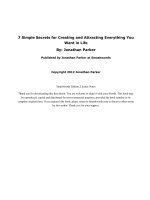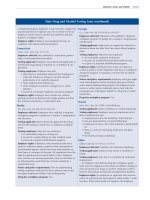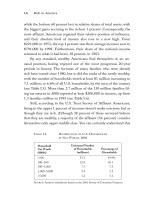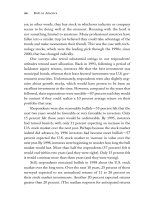Rich in America Secrets to Creating and Preserving Wealth PHẦN 8 doc
Bạn đang xem bản rút gọn của tài liệu. Xem và tải ngay bản đầy đủ của tài liệu tại đây (158.96 KB, 23 trang )
that doctors are among the most likely to overfund their retirement
plans, but they’re a special case: They do it because these plans are
also asset-protection vehicles. In case of a malpractice claim, credi-
tors generally can’t get to the money within a retirement plan; it’s
not transferable. This rule does vary state by state and by the type of
retirement plan, so if you’re moving, your IRA or other plan may no
longer be protected.)
There’s another reason you should be saving for retirement,
besides having money to live on later: tax advantages. Retirement
plans allow you to put your money into tax-deferred savings, thanks
to the many government-sanctioned vehicles for accumulating money.
Not only can you defer taxes on the interest generated by a retire-
ment account, but your contributions will generally be excluded
from your taxable income, as will contributions made on your behalf
by your employer. The earlier you start thinking about taking
advantage of these tax-deferred vehicles, the better off you will be in
future years.
Retirement 167
Tax Savings
The impact of tax deferral on retirement savings is impressive.
The sooner you start saving, the more dramatic the results. If
you contribute $3,000 each year to an IRA (the new maximum, as
of 2003) and it receives an 8 percent annualized return, after 20
years the balance would be $148,000; after 30 years it grows to
$367,000; and after 40 years you would have saved $839,000.
Although $3,000 may seem like an inconsequential amount, it
does grow to a substantial sum if you start early and stay the course
(see Figure 5.2).
05 Chapter Maurer 6/20/03 5:14 PM Page 167
168 Rich in America
Future Value of Annual $3,000 IRA Contributions at an 8% Annualized Return
$839,000
$367,000
$148,000
$0
$100,000
$200,000
$300,000
$400,000
$500,000
$600,000
$700,000
$800,000
$900,000
20 30 40
Years
FIGURE 5.2 FUTURE VALUE OF ANNUAL IRA CONTRIBUTIONS
Individual Retirement Accounts
The number of available individual retirement vehicles is exten-
sive, but they are also limited. Tax codes specify how your money
may or may not be taxed, how much money you can contribute to
individual retirement plans, and what portion of those contribu-
tions is tax-deductible. Your choices are discussed in the following
paragraphs.
Individual Retirement Accounts (IRAs) provide tax-deferred
growth and, in some cases, a current income tax deduction. In order
to be eligible to contribute to an IRA, you must have earned income.
For tax year 2003, you could contribute up to $3,000 of your earnings.
You also may contribute an additional $3,000 for a nonemployed
spouse, raising your total household contribution to $6,000. For tax-
payers over the age of 50, starting in 2002, you will be able to make an
additional catch-up contribution of $500 per year for tax years 2002
to 2005 and $1,000 per year for tax year 2006 (adjusted for inflation
starting in 2007).
05 Chapter Maurer 6/20/03 5:14 PM Page 168
If you qualify, you may be able to deduct all or part of your
IRA contribution from your taxable income. For example, you can de-
duct the entire amount if neither you nor your spouse is covered by a
qualified retirement plan. Otherwise, as your income increases, the
amount available for deduction decreases and is eventually phased
out entirely. However, tax law restrictions have made it impossible
for many individuals to fund individual retirement accounts on a
fully tax-deductible basis when they are considered “active partici-
pants” in employer-sponsored retirement plans and have an adjusted
gross income (AGI) over specified levels.
For married couples, the active participation of one spouse in an
employer-sponsored plan is enough to trigger possible limitations on
IRA deductions for both spouses if AGI limits are exceeded.
Nonemployed Spousal IRAs
If one spouse actively participates in an employer-sponsored plan and
the other does not, the nonparticipant spouse may make a deductible
IRA contribution of up to the maximum allowable for that year if the
AGI on the joint return is $150,000 or less. The deductible amount is
phased out with AGI over $150,000, with full phase-out at $160,000.
The current law does not index these AGI limits for inflation.
Nondeductible Traditional IRAs
Individuals (and nonemployed spouses) with $3,000 of earned income
in 2003 whose AGI exceeds the aforementioned limits may choose to
make contributions to a nondeductible IRA.
Nondeductible Roth IRAs
Although no tax deductions are allowed for Roth IRAs, they offer a
feature that may be even more attractive than an upfront deduction.
Retirement 169
05 Chapter Maurer 6/20/03 5:14 PM Page 169
Specifically, withdrawals after age 59
1
⁄2 will be tax-free provided the
Roth IRA has been in existence for more than five years. Also, you
are not required to take minimum distributions at age 70
1
⁄2, as you
would with most other retirement plans. As with traditional IRAs,
contributions to a Roth IRA may only be made by individuals whose
earned income is at least equal to the contribution amount. A Roth
IRA contribution may also be made on behalf of a nonworking spouse.
The allowable contribution will phase out for single taxpayers whose
AGI is between $95,000 and $110,000 (or $150,000 to $160,000 for
joint filers).
Any child can contribute to a Roth IRA, assuming he or she has
some earned income and adjusted gross income of no more than
$110,000, which is probably a good assumption for most children (still,
14-year-old Daniel Radcliffe earned exactly $110,000 for his starring
role in Harry Potter and the Sorceror’s Stone; however, for his next movie,
Harry Potter and the Chamber of Secrets, he made $3 million). Yet, many
kids earn money from doing chores, delivering papers, or babysitting,
and some manage to find summer jobs that can be fairly lucrative, on a
small scale. All these can count as earned income (the money can’t be
dividend income—the child must truly work for the money).
A gift also can be made in order to help someone else build up a
nice retirement fund. For example, let’s say your college-aged daugh-
ter made $10,000 this past summer during her vacation; you can give
her $3,000 to set up a Roth IRA even though she’s already spent all
the money she made. The government doesn’t care how she spent the
money; it simply requires that she made enough money to establish
the contribution (this assumes that you already haven’t given her the
full $22,000 gift allowable under current rules).
Although they may not be able to make contributions to a tradi-
tional IRA, individuals who continue working after age 70
1
⁄2 may
continue to make contributions to a Roth IRA, provided the income
limitations are not exceeded. Roth IRAs do not require minimum dis-
170 Rich in America
05 Chapter Maurer 6/20/03 5:14 PM Page 170
tributions. Therefore, if you are retired and don’t need income from
your Roth IRA, you have the option of allowing your money to con-
tinue compounding tax-free. This tax-free growth also may be passed
on to Roth IRA beneficiaries. Unlike the original Roth IRA owner,
the beneficiaries of a Roth IRA must withdraw the account’s funds over
time and according to IRS regulations.
Retirement 171
Traditional versus Roth IRA
Investors who can participate in the new Roth IRA may receive
significantly more after-tax income during retirement from that
account than from traditional IRAs (both deductible and non-
deductible).
In general, the longer the period of investment before retire-
ment, the greater the advantage of the Roth IRA, since earnings
compound tax-free over a longer period of time. If the IRA assets
will not be used during the investor’s lifetime and will be passed to
the next generation, the greater the advantage of the Roth IRA,
since there are no required minimum distributions to deplete the
Roth IRA account during the contributor’s life.
Be aware that this comparison hinges upon certain variables,
such as tax rates at the time of your contributions and when you
retire, the length of time remaining until withdrawal, and pro-
jected rates of return. If you do qualify for a Roth, fund it to the
maximum extent allowable.
If a Roth IRA has been in existence for less than five years, with-
drawals are presumed, for tax purposes, to come first from contribu-
tions (as opposed to earnings). Since contributions are considered a
return of capital, no tax or penalty is due on contributions regardless
of when they are withdrawn. However, earnings withdrawn before the
05 Chapter Maurer 6/20/03 5:14 PM Page 171
age of 59
1
⁄2 from a Roth IRA in existence less than five years will be
subject to both income tax and a 10 percent penalty (as always, certain
exceptions may apply).
Rollover to a Roth IRA
Note that a traditional IRA may be rolled over into a Roth IRA if
your AGI is $100,000 or less.This $100,000 AGI limit applies to both
single and married filers. Income taxes (but no penalties—unless
the Roth IRA is not held for at least five years) will have to be paid on the
rollover, however. Such rollovers may be a good idea, depending on cur-
rent and future tax rates and whether you have non-IRA funds avail-
able to pay the taxes due. If you have low or depressed stock values,
consider it a good time to convert a regular IRA into a Roth IRA
because when you do, it becomes taxable income, but you’ll have no
future capital gains to worry about.
If the value of your traditional IRA account is not depressed, it
may not make sense to convert from a traditional IRA to a Roth IRA.
As noted above, doing so will accelerate income tax with respect to
your IRA assets. Therefore, the decision to convert a traditional IRA
into a Roth IRA must be carefully examined. Some of the key factors
to consider in making this decision include:
• How much time you have until you begin taking the money
out, and how long you expect to be making withdrawals after
retirement.
• The total amount you might convert, since you would have to
pay taxes on the taxable portion of the rollover.
• Your current tax bracket and projected tax bracket after retire-
ment.
• For those over age 70
1
⁄2, whether you have made the proper
distribution elections, and if a spousal rollover is possible.
172 Rich in America
05 Chapter Maurer 6/20/03 5:14 PM Page 172
Other Retirement Plans
Qualified Plans
These include pension plans, 401(k) plans, profit-sharing and savings
plans, Keoghs, employee stock ownership plans (ESOPs), qualified
annuities, and stock bonus plans. Such plans can be divided into two
broad categories: defined contribution plans and defined benefit plans.
Each type of plan is distinct in its characteristics and tax rules. In gen-
eral, however, you need to know which of your company plans are
qualified and the distribution options available for each plan, such as a
lump sum or annuity payment.
401(k)s
As with other retirement plans, the 401(k) lets you place a portion
of your pretax salary into a retirement account. Not only do your
savings grow tax-free, but many employers will match some or all of
your contributions. At a minimum, you should make contributions
to the extent your company matches all or some of them. Failing to
take advantage of this option is like turning down a small bonus.
The amount contributed by you and your company is not taxable
until withdrawal. Although your company’s matching contribution
may not be yours to keep if you end employment before the con-
tribution vests, your prior contributions and their earnings always
belong to you.
Defined Benefit Plans
These plans pay a fixed monthly amount of income at retirement
period. The benefit payable to you is based on a complex formula, tak-
ing into account your earnings and years of service. Contributions to
these plans are almost always made entirely by the employer.The most
common defined benefit plan is an employer pension plan.
Retirement 173
05 Chapter Maurer 6/20/03 5:14 PM Page 173
Annuities
Most defined benefit plans pay out in the form of an annuity although
some provide for a discounted lump sum payment. An annuity is a
stream of payments usually lasting for the life of the retiree (called by
the legal-sounding term annuitant). If you choose to take a reduced
annuity payment, a second or joint annuitant (usually a spouse) also
can receive a payment if he or she outlives you. Typical joint annuitant
options include 100 percent joint and survivor ( J&S), in which each
person receives the same payout, regardless of the order of death; 50 per-
cent J&S, where the surviving joint annuitant receives 50 percent of
the annuitant’s payment; and other options. You also can guarantee
the number of payments (called a term certain option).
The more protection you provide for the joint annuitant (e.g., your
spouse), the smaller the payment to the annuitant (you). In the case of
a married couple, the greater the sum of assets owned by the couple,
the lesser the need to protect the surviving spouse with an annuity. If
necessary, an estate can be augmented with life insurance on the life of
the retiree (but as we’ve discussed, life insurance can be very expensive
when you buy it at retirement age). An annuity may be attractive if you
seek a safe, secure, guaranteed stream of level payments during the life
of the surviving spouse.
The risks of an annuity are twofold:
1. An annuity offers inadequate protection in an inflationary
environment.
2. The family may suffer a financial loss if the annuitant dies
early in retirement and there is no joint annuitant, or if both
annuitant and joint annuitant die early in retirement.
For more on annuities, see Chapter 6.
174 Rich in America
05 Chapter Maurer 6/20/03 5:14 PM Page 174
Profit-Sharing Plans
These plans allow employees to share in the company’s profits, al-
though showing an actual profit by the company is not necessary for
a contribution to be made on your behalf. Each year the company
can designate a varying percentage to be set aside for the benefit of
its employees. Often, these funds are controlled by the company, not
the employee.
Savings Incentive Match Plan for Employees (SIMPLE)
Companies with 100 or fewer employees (and no other plans) can
establish this inexpensive retirement plan. Employees can defer up to
$7,000 of their income into these plans (the figure increases annually
after 2002). Employers, too, generally must make contributions on
behalf of their employees, usually 2 to 3 percent per employee. These
plans operate like a no-frills 401(k) plan.
Retirement 175
The 2001 Tax Law
The 2001 tax law has created significant changes to retirement
planning vehicles. For instance, since 1981 there has been a $2,000
limit on contributions to IRAs; beginning in 2002, the new law
permits contributions of up to $3,000, and the allowable contribu-
tion amount increases gradually to $5,000 by 2008. To help those
closer to retirement, the new law contains a catch-up provision,
allowing those age 50 and older to save more. For instance, in 2002,
they can contribute up to $3,500 to an IRA, and the catch-up
provision increases gradually to $6,000 by 2008. After 2008, these
amounts will be adjusted for inflation in increments of $500.
As always, remember that there will be complex participation
and coverage rules.
05 Chapter Maurer 6/20/03 5:14 PM Page 175
Nonqualified Plans
Nonqualified plans are often used to supplement benefits that are other-
wise limited by IRS rules. They can be broken down into two broad
categories: the employee elective plan and the excess or supplemental
benefit plan. In the employee elective plan, your company takes money
from your upcoming bonus (or deducts money from each paycheck)
and puts it into a retirement plan; this money is not considered income
and will continue to grow. These plans are generally available only to a
select group of employees, such as highly compensated executives or
senior management.
The excess or supplemental benefit plan also applies to highly
compensated employees. Let’s say 15 percent of your compensation up
to $200,000 is taken into account for a company’s qualified retirement
plan, but you earn $350,000; a percentage of the excess ($150,000) can
be contributed to a nonqualified benefit plan.
Nonqualified plans that are not available to all employees and
are usually designed for senior executives or highly paid employees are
(naturally) not qualified (under IRS rules) and are not eligible for
favorable tax treatment upon distribution or rollover to an IRA. On
distribution, nonqualified plan payments are subject to ordinary income
tax (and in some cases Social Security taxes), but are not subject to any
minimum distribution rules or age distribution rules.
A variety of nonqualified plans exist, including elective deferred
compensation plans, long-term incentive plans, benefit equalization
plans, excess (additional) pension plans, and restricted stock plans, to
name a few. The decision to defer within these plans or to continue
deferral upon an award maturity is usually made during employment.
You must be aware of when your plan assets will be distributed and
what investment allocation choices, if any, are available within your
plan. If such plans are pegged to company stock performance and paid
176 Rich in America
05 Chapter Maurer 6/20/03 5:14 PM Page 176
in the form of shares of stock, they are subject to ordinary income tax
upon distribution.
The advantages of these plans are that they are nontaxable in the
year of deferral, offer compounded tax-deferred growth, can be paid
out when you’re in a lower tax bracket, and may not be subject to
state tax if you do not reside in the state at the time the funds are dis-
tributed to you. The disadvantage of these plans is that they gener-
ally are not funded. In other words, if you elect to defer a portion of
your salary, say $1,000, and earmark it for this plan, your company
won’t pay that amount to you, but also won’t necessarily set it aside
for you, either. Your employer must keep track of it as if you actually
made a deposit, and promises to pay you that sum plus the hypo-
thetical return on it. But the money doesn’t physically exist in an ac-
count for you.
Nonqualified plan assets are also unsecured, which means they’re
subject to the company’s general creditors in the event of insolvency or
bankruptcy (although there are various trusts the money can go into
that can protect part of it). These plans are also subject to rescission if
management decides to terminate the plan, or if there is a change in
control and new management makes that decision.
Certain irrevocable trusts (so-called rabbi trusts) can be used to
lessen the risks associated with nonqualified benefits, but complete
protection of your money from a company’s general creditors is vir-
tually impossible without causing the funds to be taxable to you on a
current basis. As with regular qualified plans, the payouts from non-
qualified plans are taxed as ordinary (compensation) income when
you withdraw them; moreover, the money may be subject to the FICA
(Social Security and Medicare) tax at that time. That is, if you retire
and take the payments over a period of time, they may be subject to
FICA taxes, whereas when you were working they may well have been
over the FICA limit.
Retirement 177
05 Chapter Maurer 6/20/03 5:14 PM Page 177
IRA and Qualified Plan Beneficiary
Designations
Just as important as putting money into a plan is making sure that you
withdraw it correctly. You’ll want to ensure that your IRA beneficiary
designations—the forms you complete specifying to whom the money
178 Rich in America
Lump-Sum Distributions from Qualified Plans
Depending on your specific personal financial situation, you might
prefer to elect the lump-sum option from a qualified plan. Here
the monies from an entire fund are distributed within one calen-
dar year. A taxable lump-sum distribution like this will be taxed
in full in the year you take the distribution. A tax-free lump-sum
distribution can be achieved by rolling the money into an IRA
account or another qualified retirement plan, such as a 401(k),
within 60 days of distribution.
If you roll it over from trustee to trustee, no tax will be withheld.
If you want to take the money and then put it into a new plan
within a 60-day period, the plan administrators withhold income
taxes. Any distribution not rolled over will be subject to taxation.
However, favorable tax treatments may still be available for the
amount not rolled over, providing you participated in the plan for
at least five years, and you were born prior to January 1, 1936 (or
were at least 59
1
⁄2 at the time of distribution).
The rules concerning the favorable taxation of lump-sum dis-
tributions are varied and complex. They include such concepts as
10-year averaging, 20 percent capital gain treatment on pre-1974
allocation ratios, and special treatment for in-kind distribution of
employer stock. Consult a tax or financial professional about tax
treatment of your lump-sum distribution before you dismiss it in
favor of an IRA or other rollover.
05 Chapter Maurer 6/20/03 5:14 PM Page 178
will go upon your death—are completed properly. In doing so, you’ll
assure that your account is transferred in accordance with your objec-
tives. For instance, if your will directs that your property be divided for
and distributed to trusts for your minor children, then your benefici-
ary designation should be arranged in the same way. One of the most
common estate planning mistakes we encounter is lack of coordina-
tion between a well-drafted will and retirement plan beneficiary des-
ignation forms.
The beneficiary designations that you have on file with the trustee
or custodian of your IRA determine not only to whom the account
will pass, but also how required minimum distributions (RMDs) will
be calculated during your life as well as after your death. Thus, it’s
important to ensure that the beneficiary designation form you have on
file with your IRA trustee [or 401(k) administrator] is not only con-
sistent with what we call your wealth-transfer objectives, but also is
drafted in a tax-savvy manner. You should revise the form as often as
is necessary to reflect changes in your personal circumstances or per-
sonal financial situation.
In general, the RMD rules require you to begin taking minimum
annual distributions from IRAs and other qualified retirement
accounts starting no later than April 1 of the year following the year
you turn 70
1
⁄2 (in most instances you can defer it longer if you are still
actively working at that age). The amount of your RMD is calculated
based on the ending balance of the IRA as of December 31 of the pre-
vious year divided by the appropriate life expectancy factor. For exam-
ple, if your IRA has a balance of $400,000 as of December 31, 2002,
your RMD for 2003 would be $16,194.33, assuming you are 73 years
old ($400,000/24.7). You are always free to take more than the RMD
amount. However, if you take less, the shortfall is subject to a 50 per-
cent penalty. If assets remain in your plan at death, the beneficiaries
you designate in your beneficiary designation form will determine to
whom and how the benefits are paid.
Retirement 179
05 Chapter Maurer 6/20/03 5:14 PM Page 179
You may name two types of beneficiaries for your IRA:
1. A primary beneficiary is an individual, group of individuals, or a
legal entity to whom your IRA will pass upon your death.
2.A secondary beneficiary becomes the designated beneficiary
if the primary beneficiary is not living at the time of your
death, or if the primary beneficiary disclaims all or a portion
of your IRA.
Careful consideration of the beneficiary allows you to take advantage
of significant planning opportunities. Consider the executive who
wanted to give half of his 401(k) assets to his family foundation and
half to his children. He named his estate as beneficiary and then exe-
cuted a will with the foregoing dispositions described. Unfortunately,
by taking these steps, he caused his entire 401(k) assets to become tax-
able income after his death, which meant that after taxes, a much
smaller amount than he intended will pass on to his family foundation
and children.
By simply taking the right steps, he could have benefited both
his family and his charity. Instead of naming his estate as the benefi-
ciary, the executive should have divided his IRA into two separate
accounts during his lifetime. For one of his IRA accounts, he should
have designated his children as equal beneficiaries; for the other, he
should have named his family foundation as sole beneficiary. By
doing this, the income tax owed after his IRA passes to his founda-
tion would be taxable to his foundation, rather than to his estate. Since
his foundation is a tax-exempt entity, it is not required to pay income
tax, so the IRA funds it receives are entirely tax-free. His children,
too, would have benefited from the ability to withdraw the other one-
half of the IRA over their life expectancies—something they would
not have been able to do had the foundation been a beneficiary of the
same IRA.
180 Rich in America
05 Chapter Maurer 6/20/03 5:14 PM Page 180
Retirement Plans for
Small Business Owners
Recent tax legislation regarding retirement plans can provide excellent
tax-saving opportunities for small business owners. In addition to the
contributions allowed to a SEP and Keogh, small business owners can
now make an additional contribution of up to $11,000 (or $12,000 if
you are over 50 years old) using the new solo 401(k) plan. This plan
gives you investment flexibility, and permits participants to borrow up
to $50,000, or one-half the balance, whichever is less. Existing SEP
and/or Keogh retirement accounts may be consolidated into the solo
401(k) plan.
Let’s say you have $50,000 in self-employed income and can con-
tribute up to $9,291 to a SEP or a Keogh. With this new plan, you can
contribute up to $20,291 (or $21,291 if you are over 50). You cannot
exceed $40,000 in contributions to all your plans (unless you are over
50, in which case, again, you can add another $1,000). The solo 401(k)
plan must be set up by December 31 or the last day of the proprietor’s
fiscal year.
Retirement Plan Options
for the Self-Employed
If you are self-employed, you may have not thought much about
employee benefits. If so, you are missing out on providing the advan-
tages of a retirement plan to one of your most valuable employees:
yourself.
As previously discussed, the advantage in establishing a retirement
plan is that contributions and investment earnings grow tax-deferred
until distributions from the plan begin. Withdrawals generally begin
at normal retirement age, by which time you may be in a lower tax
bracket than during your younger years. Even if you’re not in a lower
Retirement 181
05 Chapter Maurer 6/20/03 5:14 PM Page 181
tax bracket, the tax deferral afforded over many years can significantly
increase your wealth.
Generally, you can establish a retirement plan if you have nonwage
income from performing personal services, including director and
consultant fees. A plan can be established regardless of whether you
are self-employed part time or full time, or even if you participate in a
plan offered by your full-time employer (subject, as always, to certain
restrictions). Profitability is not required to establish a plan. However,
you must have some net self-employment earnings to make annual
contributions, depending on the type of plan you establish. The maxi-
mum annual earnings taken into account for plan contributions were
$200,000 for 2003, and will be adjusted annually for inflation.
Your choice of retirement plan should be based on your objectives.
Depending on the type of plan you choose, your maximum annual
allowable contribution can vary; this is usually the key consideration in
selecting a plan. Other considerations are flexibility in making contri-
butions, costs involved in establishing and maintaining the plan,
annual filing requirements, and withdrawal obligations and limita-
tions. It also is important to note that if you have employees, you may
have to make a contribution on their behalf once they satisfy the eligi-
bility requirements outlined in the plan. Very strict nondiscrimina-
tion rules and coverage tests must be followed in order for the plan
to maintain its qualified status. Please consult with your tax advisor to
determine if this applies to your situation.
The most common retirement plans for self-employed individuals
are defined-contribution and defined-benefit plans, otherwise known as
Keoghs. Contributions to these plans are based on net self-employment
income earned.The plan must be established by your taxable year-end,
but contributions do not have to be made until your tax-filing dead-
line, including extensions.
In the paragraphs that follow some tax-deferred plans available to
self-employed individuals are described. Contributions to these plans
182 Rich in America
05 Chapter Maurer 6/20/03 5:14 PM Page 182
are fully deductible. However, limitations and restrictions may apply if
you maintain more than one plan.
Defined-Contribution Plans
A defined-contribution plan is a qualified plan that provides an indi-
vidual account for each participant; benefits are based solely upon the
amount contributed to the participant’s account. The most commonly
established defined-contribution plans for the self-employed are profit-
sharing and money purchase plans.
Profit-Sharing Plan (PSP)
This type of plan allows you to contribute up to 25 percent of com-
pensation (capped at $200,000 for 2003) or $40,000, whichever is less,
on a discretionary basis from year to year.
Money Purchase Pension Plan (MPPP)
An MPPP allows you to contribute up to 25 percent of compensation
or $40,000, whichever is less, with a fixed contribution percentage
determined when you set it up. Unlike the profit-sharing plan, contri-
butions to an MPPP are mandatory in any year that there is earned
income. Prior to 2002, MPPPs were often set up in conjunction with
a PSP. With the changes introduced by the 2001 Tax Act, however,
there is seldom any need to establish an MPPP with a PSP.
Defined-Benefit Plans
The annual contribution to a defined-benefit plan is based on the
amount that must be put aside today to provide you with a fixed ben-
efit at retirement.The contribution amount is calculated using actuar-
ial data, factoring in your current age and projected retirement age,
Retirement 183
05 Chapter Maurer 6/20/03 5:14 PM Page 183
current annual income, the required annual benefit (limited to a per-
centage of earnings), and the projected investment growth rate.
The annual contribution limit to one of these plans may be much
higher than with a defined contribution plan, and the amount will be
tax-deductible. Also, these plans can be funded to provide a benefit at
retirement equal to 100 percent of average annual compensation up to
$160,000 (indexed each year for inflation). That arrangement allows
for a quick buildup of retirement assets, particularly for older partici-
pants, but once the benefit formula is determined, the annual con-
tributions are mandatory. However, these plans can be expensive to
administer.
Simplified Employee Pension (SEP)
A SEP is a retirement plan that allows you to contribute up to 25
percent of compensation (limited to $200,000 in 2003) or $40,000,
whichever is less, on a discretionary basis from year to year. The plan
must be established and funded by your tax-filing deadline (plus
extensions). A SEP is similar to a profit-sharing plan in that you can
choose whether to make a contribution, and how much, on a year-to-
year basis. However, it is easier to maintain because there are no on-
going IRS filing requirements as with qualified plans. Still, a penalty is
applied to excess contributions.
Savings Incentive Match Plan for Employees
(SIMPLE)
These plans are a relatively new option for small employers; here a
self-employed individual is considered both as an employee and em-
ployer. As an employee, you can elect to contribute up to $7,000 (adjusted
for inflation) to the plan every year. In addition, as the employer, you
must make annual contributions in one of two ways:
184 Rich in America
05 Chapter Maurer 6/20/03 5:14 PM Page 184
1. Through matching dollar-for-dollar contributions up to 3
percent of net earnings from self-employment for the calendar
year, up to $7,000. This figure may be reduced to a percentage
of not less than 1 percent in any two out of five years.
2. Through making nonelective contributions equal to 2 percent
of net earnings from self-employment, regardless of whether
any employee contributions are made, allowing for a current
maximum contribution of $4,000.
Generally, a SIMPLE does not provide the maximum benefit if you
do not have employees who also need to be covered. This is because
the contribution limits are generally lower than those under other
plans, and the SIMPLE must be your only plan.
Retirement 185
Insurance
Investors interested in retirement vehicles have shown a resurgent
interest in sophisticated life insurance products, such as private
placement variable life insurance products, or using insurance as a
“wrapper” for investing in hedge funds or marketable securities
(for more information on life insurance, see Chapter 4).
One especially popular product is variable life. Here you pay
cash premiums into a life insurance policy, and then determine how
that cash is to be invested. The options include several nonpublic
mutual funds, among other choices. Unlike the case of mutual funds,
however, you don’t handle the money; the manager does, and you
have no control over his or her actions, although you can have a say
in who it is. For instance, you can ask that a place like U.S. Trust
handle it, and the life insurance company will then contract with
U.S.Trust to perform the specified task.That money is now inside an
insurance product, so all the gains and taxable elements are tax-free.
05 Chapter Maurer 6/20/03 5:14 PM Page 185
186 Rich in America
Charitable Remainder Trusts as Retirement Plans
A note on charitable remainder trusts (CRTs) is in order. We’ll
talk more about CRTs in Chapter 6, but they are also a retirement
plan possibility. With a CRT, you bestow your money or other
assets on a favorite charity that you wish to receive whatever
asset(s) you eventually give away—but not at the moment. In the
meantime, you, your spouse, or your children (or anyone else you
select) will be paid a fixed dollar amount or a percentage of the
value from the assets in the trust.
There are many ways to structure these CRTs that may help
you retire well. One way is through a net income makeup CRT
(NIMCRT). As with a regular CRT, you place property into a
CRT, retain a stream of payments from the trust, and at the end of
your life, the balance goes to your selected charity. You can struc-
ture this in such a way that it will pay out the lesser of the income
generated by the trust, or the stated percentage payout. Assuming
that payout is 6 percent, but the trust has no current income, there
is nothing available with which to pay you, so the trust “owes” you
the payout. In this way, you can accumulate assets inside these
vehicles, letting them grow and compound tax-free, and then
change the investment allocation to produce an income later on,
when you need it.
The IRS allows this arrangement in part because it’s legal, but
also because you do risk a downside. If you die during the period
you are accumulating the money, then all of that money goes to
your charity.
05 Chapter Maurer 6/20/03 5:14 PM Page 186
187
E
state planning allows you to meet your objectives for the
disposition of your assets during your lifetime, and after your
death. Often associated with making a will, this kind of planning can
involve intergenerational wealth transfer and philanthropic planning.
As with financial planning, estate plans generally need to be reviewed
about every five years, or whenever there is a significant change to your
personal situation, or when there’s a change in the laws affecting your
overall wealth management situation.
CHAPTER 6
Estate Planning
The day is not far distant when the man who dies leaving
behind him millions of available wealth, which was free
for him to administer during life, will pass away “unwept,
unhonored, and unsung,” no matter to what uses he leave
the dross which he cannot take with him. Of such as these
the public verdict will then be: “The man who dies thus
rich dies disgraced.” Such, in my opinion, is the true gospel
concerning wealth, obedience to which is destined some day
to solve the problem of the rich and the poor.
—Andrew Carnegie,
American industrialist and philanthropist
Money is better than poverty, if only for financial reasons.
—Woody Allen,
American filmmaker
06 Chapter Maurer 6/20/03 5:19 PM Page 187
U.S. Trust Survey of
Affluent Americans Results
Eighty-four percent of estate planning respondents surveyed have
already drawn up a will, while 70 percent say that they have a formal
estate plan. Forty-nine percent have reviewed their wills in the last five
years, and 53 percent review their wills every three years.
Eighty-nine percent of married respondents have discussed their
estate plan with their spouse, and 86 percent have named an executor.
A spouse was the most common executor/trustee (cited by 47 percent
of respondents).
Thirty percent of respondents estimate that their estates will be
valued at somewhere between $1 and $5 million at the time of their
death. Another 29 percent estimate their estate to be worth between
$5 and $10 million; 25 percent assume their estates will be larger (see
Table 6.1).
Fifty-nine percent plan to donate at least part of their estate to
charity, 58 percent will give money to colleges or academic institu-
tions, 45 percent to health-related organizations, 34 percent to religious
institutions, 24 percent to charities related to public issues such as the
environment or politics, and 20 percent to libraries or museums.
Eighty-four percent of respondents said that they will treat their
children on a totally equal basis in their wills. But certain circumstances
188 Rich in America
Estimated Value of Estate at Death Percentage of Respondents
Less than $1 million
$1 million to less than $5 million
$5 million to less than $10 million
$10 million to less than $25 million
$25 million or greater
5%
30%
29%
17%
8%
TABLE 6.1 ESTIMATED VALUE OF ESTATE AT TIME OF DEATH
n = 155
SOURCE: U.S. Trust Survey of Affluent Americans XIX, December 2000
06 Chapter Maurer 6/20/03 5:19 PM Page 188
warrant a reevaluation, and 74 percent said that the child’s mental
health is extremely or somewhat important in determining what a
child will inherit, 70 percent said the same for a child’s physical health,
53 percent said a child’s ability to manage money wisely is important,
and 51 percent said a child’s ability to get and keep a good job matters.
The least important issues cited were the age and sex of a child, and
which child the parent feels closest to.
On average, respondents thought the age of 29 years is the young-
est at which a child should be entrusted with a significant inheritance.
The average respondent felt that a child would have to inherit $3.4
million before the size of the inheritance would have a detrimental
effect on his or her values.
Estate Planning Scenarios
Not long ago we had a very successful client who had made many mil-
lions of dollars in several different companies, all of which he had
started himself. He also owned five cars, a plane, three homes, and was
the father of two teenage children. Unlike most of our clients, the
order of the items in that list seemed to represent their importance in
his heart. For whatever reasons, when it came time to take care of his
estate planning, he wasn’t interested.
“I don’t care about making a will,” he said, “I made my own
money. My kids will have to make their money, too.” We told him that
he certainly didn’t have to leave his children everything, but that it
might be nice for them to inherit at least something. He said he would
think about it, but that since no one ever left him anything, he didn’t
see why he should have to leave anyone anything.
His reaction to the next question was a little more discouraging.
We asked his preferences concerning a guardian for the kids in case
anything were to happen to him. “I don’t care,” he said. “The court can
appoint someone.” Once again, we engaged him in a conversation. It’s
not our job to change people’s values, but we do want people to be fully
Estate Planning 189
06 Chapter Maurer 6/20/03 5:19 PM Page 189









